In the blog series on jewellery, we will focus on the jewellery traditions of various countries in North Africa and South-West Asia. These jewellery traditions go further back in history than the geographical borders we know today, and of course, one country may be home to several cultural traditions. Both the historical context and the cultural heritage of a variety of peoples are visible in the jewellery worn, and we hope to introduce this wider scope of adornment and dress to you. In this post, we will look at the long history of jewellery in Iraq.

Early cities
Iraq is home to the two rivers that provided the perfect circumstances for early civilisation: the Tigris and the Euphrates. The ancient name Mesopotamia refers to these two rivers, as it literally means ‘between rivers’. The rivers provided not only fertile ground but also formed trade corridors with southern Anatolia as well as with the Indus Valley to the east. It is not surprising that these circumstances gave rise to some of the earliest cities and city-states.
In the north of Iraq, near current-day Mosul, Tepe Gawra was a site that has been inhabited from 5,000 BCE onwards until 1,500 BCE. It’s from this place that the earliest use of gold in South-West Asia has been preserved: wire and beads form telling tales of both technological achievements and trade. Tepe Gawra grew into one of the earliest industrial cities, bringing wealth to an upper layer of its inhabitants, and that shows in the burials of the late 4
th millennium. Gold rosettes and beads, lapis lazuli from Afghanistan, and
turquoise
Turquoise: (French: turquois – present day Türkiye; Synonyms: firuze
Firuze: (Persian: pērōzah – "victory", later Arabic: fayrūz; Synonyms: firuze, pheroza), is a naturally occurring opaque mineral mined in abundance in Khorasan province of Iran and has been used for making dye for centuries. , pheroza), is a naturally occurring opaque mineral mined in abundance in Khorasan province of Iran and has been used for making dye for centuries. The term is a derivative of the French word for the country Türkiye once called Turkey. from Sinai all testify to the trade hub that Tepe Gawra was.
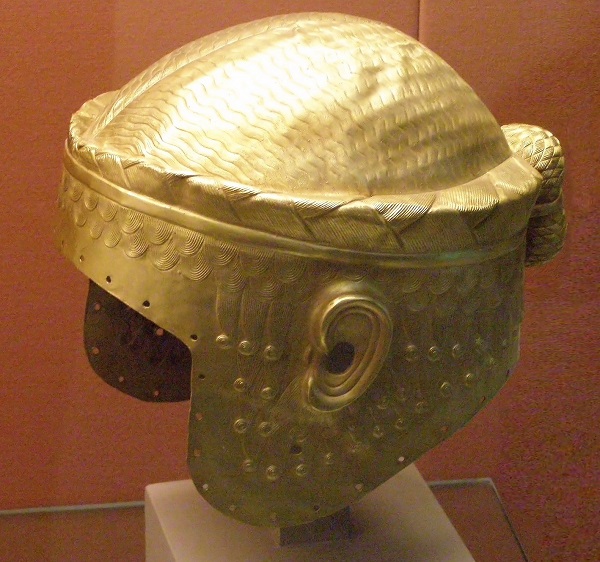 Gold helmet from Ur. Image: Wikipedia
Gold helmet from Ur. Image: WikipediaThe Gold of Ur
In the south of Iraq, the city of Ur was a major urban site in ancient Sumeria. It has gained worldwide fame for its cemetery of thousands of burials, dating to around 2,500 BCE. Only a few of these contained abundant riches, and thus were called ‘Royal Tombs’ by their excavator, Leonard Woolley. Although some of the deceased were indeed of royal status, the majority were elite members, courtiers, and attendants, buried together with their ruler. The burials contained lavish jewellery sets in gold, carnelian and lapis lazuli, and it has been proposed that the jewellery items with which each individual was interred, were somehow linked to their status and position. Certain jewellery items are only used for men, where others are mainly worn by women. A further differentiation may be seen between royal and priestly elite members. The jewellery here does not only communicate wealth but also complex organisational structures.
 The spectacular jewellery of Queen Puabi. Image: Pinterest
The spectacular jewellery of Queen Puabi. Image: PinterestQueen Puabi
Probably the most well-known burial in Ur is that of Queen Puabi. She was buried with copious amounts of jewellery in gold, lapis lazuli, and carnelian. As the roof of her tomb had collapsed in the past, it has been difficult to reconstruct the jumble of beads and other ornaments into the objects we are familiar with today. Her spectacular jewellery is also significant for more than just status and power. Recent research by Kim Benzel has shown that it may very well also have been charged with ritual or magic power. In Puabi’s jewellery, references to fertility are abundant. Vegetation and floral motifs abound, and what is more, the use of gold seems to be focusing on the upper part of the body: as if in death, she was a radiant goddess in an aura of vegetation.
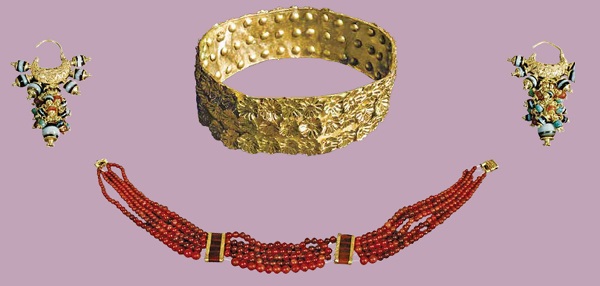 Gold jewellery from Tomb III at Nimrud. Image: Hussein 2016
Gold jewellery from Tomb III at Nimrud. Image: Hussein 2016Nimrud
In the north of Iraq, the kingdom of Assyria flourished. Here, cities like Nineveh and Nimrud bloomed. In Nimrud, ancient Qalhu, in particular, four rich tombs have been excavated at the end of the 20
th century by the Iraqi Department of Antiquities. Two queens were found buried together, Queen Yaba’, the wife of Tiglath-pileser III, and Queen Ataliya, who was married to Sargon II. From the excavation, it became clear that the queens were dressed in fabrics that were embellished with countless gold ornaments shaped like stars, rosettes, wheels, discs, and triangles, along with jewellery like diadems, bracelets, anklets, rings, and earrings. The level of workmanship achieved is superb: the woven diadem of Queen Yaba’s is technically very difficult to create. The use of eye agates is one of the ancient precursors of eye beads as they are still used today.
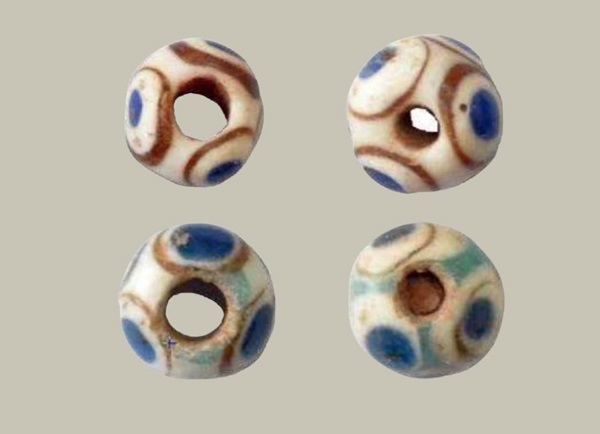 Glass beads, excavated in China. Image: Xinhua
Glass beads, excavated in China. Image: XinhuaGlass and Trade
Glass beads excavated outside of Mesopotamia, sometimes at a considerable distance, tell us more about the wide reach of the trade network. The most faraway example is a tomb from the 5
th to 3
rd century BCE in the city of Huludao in China, where glass eye beads have been excavated that were produced in Mesopotamia in the Late Bronze Age, around 1,100 BCE. Clearly, these beads have travelled quite a distance in the centuries after their creation, but also in the time of the Bronze Age itself trade routes reached far. Glass beads excavated in Europe were found to have been produced in Mesopotamia.
 Gold earring from al-Hillah. Image: The Metropolitan Museum of Art
Gold earring from al-Hillah. Image: The Metropolitan Museum of ArtMedieval Craftsmanship
During the Middle Ages, the area that is now Iraq continued to flourish as a trade hub. Baghdad was the capital of the Islamic world for a considerable time, and it is during the Middle Ages that we see forms and styles take shape that continues to be used in jewellery. The gold earring shown here for example is from the 11
th to 13
th century CE and carries the five-pointed Star of Solomon. This is still a common motif that is believed to carry amuletic power and has been in use for centuries.
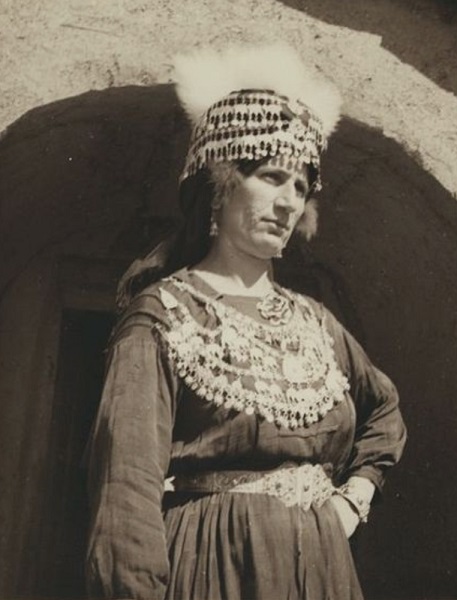 An Assyrian woman from Iraq
An Assyrian woman from Iraq Traditional Jewellery from Iraq
These international connections are still visible in the traditional jewellery of Iraq. The silver jewellery worn in Kurdistan, on the border with Syria, Turkey, and Iran transcend into the neighbouring countries as well. Forehead ornaments of linked silver quadruple chains carry characteristic crescents as well as blue pierced discs of faience. Known as
saba ‘uyun or Seven Eyes, these are found widely throughout South-West Asia but feature notably in Iraqi jewellery. The silver jewellery of the tribes inhabiting the thick marshes in the south of Iraq has its own distinct style, while in the north of Iraq, the ethnic minority known as the Assyrians still have their own jewellery styles. In the cities, Ottoman jewellery styles have found their way into the spectrum of adornment, such as the characteristic belt buckles. All in all, Iraq is home to some of the most stunning and significant pieces of human adornment and history.
This post is based on
- Alarashi, H. 2016. Butterfly Beads in the Neolithic Near East: Evolution, Technology and Socio-cultural Implications, in: Cambridge Archaeological Journal 26:3, pp. 493-512
- Benzel, K. 2013. Puabi’s adornment for the afterlife: materials and technology of jewelry at Ur in Mesopotamia. PhD-thesis, Columbia University
- Gansell, A. R. 2007. Identity and Adornment in the Third-millennium BCE Mesopotamian ‘Royal Cemetery’ at Ur, in: Cambridge Archaeological Journal 17:1, pp. 29-46
- Gansell, A.R., S.L. James & S Dillon 2012. Women in ancient Mesopotamia, in: A Companion to Women in the Ancient World, pp. 11-24
- Hussein, M.M. 2016. Nimrud. The Queens’ Tombs. Iraqi State Board of Antiquities and Heritage, Baghdad/Oriental
Oriental: (Latin and Late Middle English Adjective: orientalis – From Orient; from Latin (noun): oriri – to rise; and oriors – East), anything of an Eastern origin in relationship to Europe – Asia. The word was first used in the context of territorialization between the late 3rd and early 4th Century CE. Institute of the University of Chicago
- Maxwell-Hysop, K.R. 1960. The Ur Jewellery. A Re-Assessment in the Light of Some Recent Discoveries, in: Iraq Vol. 22, pp. 105-15
- Jenkins, M. & M. Keene 1982. Islamic Jewelry in the Metropolitan Museum of Art. The Metropolitan Museum of Art, New York
- Miller, N. F. 2000. Plant Forms in Jewellery from the Royal Cemetery at Ur, in: Iraq Vol. 62, pp. 149-155
- Peasnall, B. & M.S. Rothmann. One of Iraq’s Earliest Towns. Excavating Tepe Gawra in the archives of the University of Pennsylvania Museum, in Expedition Vol. 45 no 3, pp. 34-39
- Varberg, J. et al. 2016. Mesopotamian glass from Late Bronze Age Egypt, Romania, Germany and Denmark, in: Journal of Archaeological Science 74, pp. 184-194




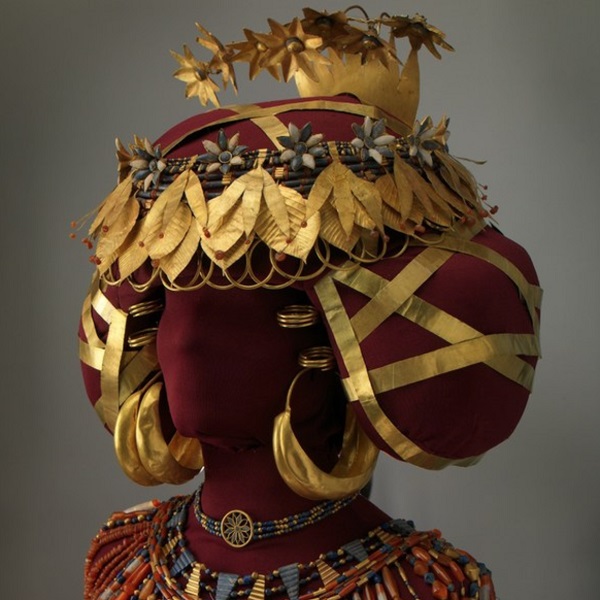

 Gold helmet from Ur. Image: Wikipedia
Gold helmet from Ur. Image: Wikipedia The spectacular jewellery of Queen Puabi. Image: Pinterest
The spectacular jewellery of Queen Puabi. Image: Pinterest Gold jewellery from Tomb III at Nimrud. Image: Hussein 2016
Gold jewellery from Tomb III at Nimrud. Image: Hussein 2016 Glass beads, excavated in China. Image: Xinhua
Glass beads, excavated in China. Image: Xinhua Gold earring from al-Hillah. Image: The Metropolitan Museum of Art
Gold earring from al-Hillah. Image: The Metropolitan Museum of Art An Assyrian woman from Iraq
An Assyrian woman from Iraq